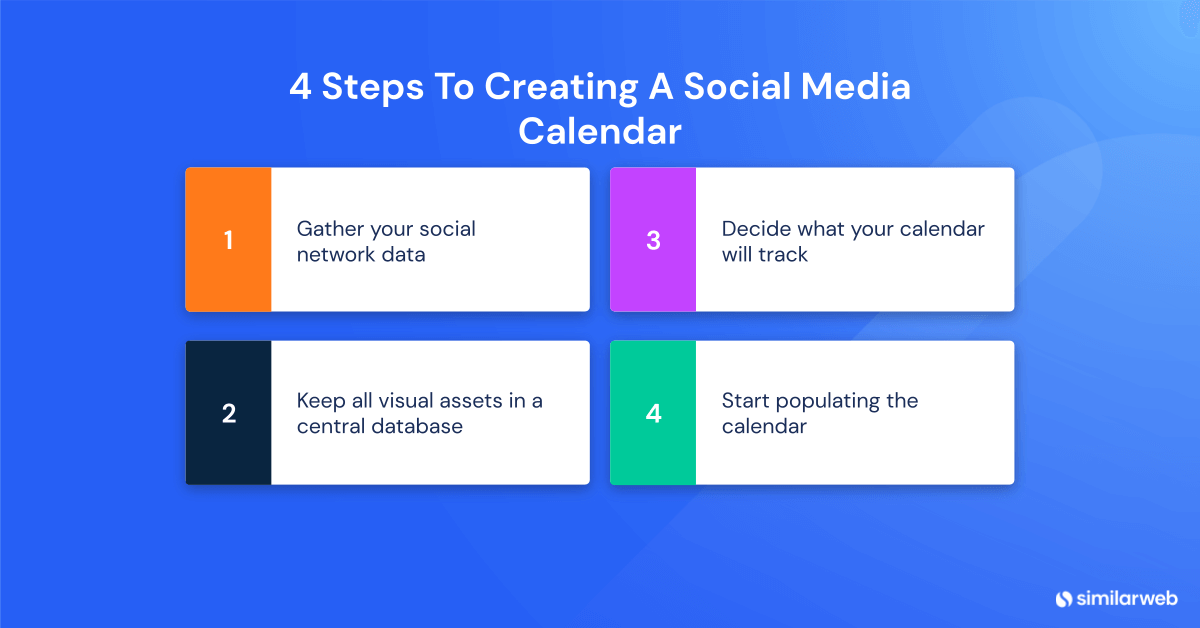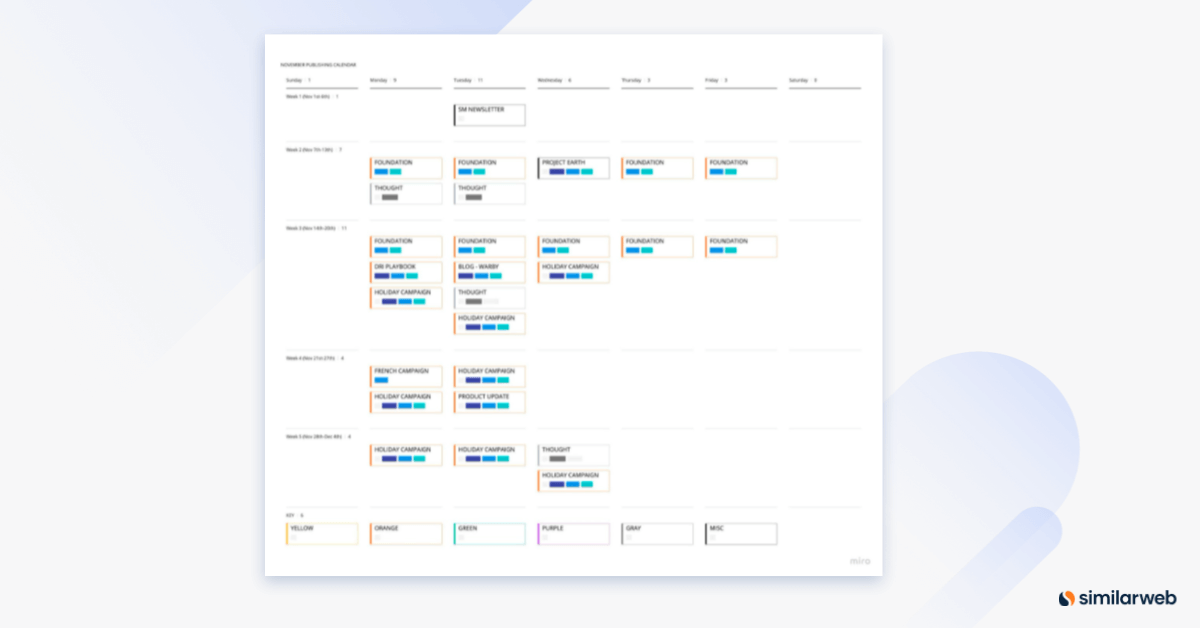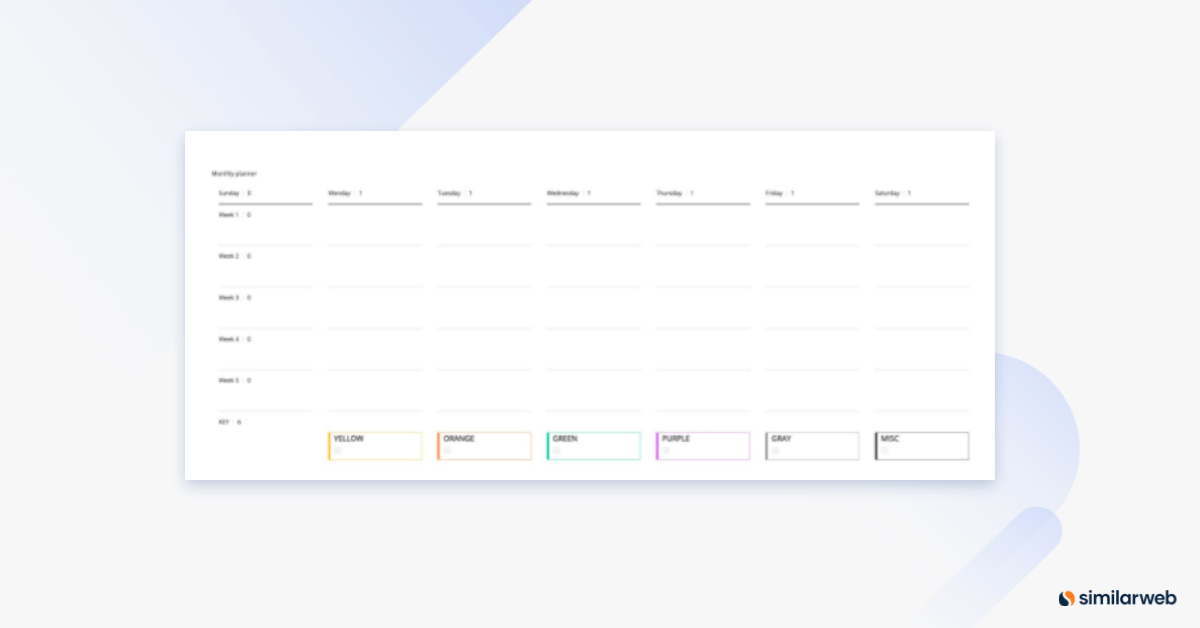How To Create A Social Media Calendar [+ Free Templates]
![How To Create A Social Media Calendar [+ Free Templates]](https://www.similarweb.com/blog/wp-content/uploads/2022/01/An-image-showing-a-cartoon-person-creating-a-social-media-calendar.-768x456.png)
73% of marketers report that their social media marketing efforts have been “somewhat effective” or “very effective” for their business. Indeed, social media has become a major part of marketing in today’s world.
A social media strategy without a planning calendar is like a train without a track. Being constantly active on social media means a business can interact directly with its audience and build brand loyalty among customers. Social media is also one of the most cost-effective marketing methods out there, with little to no costs involved, which is why no marketer should miss out on making the most of it.
But just being on social media isn’t enough. Your approach must be organized, targeted, and timely. Yet, with so many social media channels out there — from Facebook and Instagram to LinkedIn and Twitter — it can be difficult. Enter: the social media calendar.
What is a social media calendar?
A social media calendar is an organized overview of upcoming scheduled social media posts.
Your social media planning calendar could be very simple or complex, depending upon your brand’s requirements.
It might be dedicated to a single social network or combine several networks into one calendar. It might be in actual calendar format or it might be a simple spreadsheet. If you want to get fancy, there are many social media management apps with endless customizable ways to schedule posts.
Why is a calendar crucial for social media success?
You should have a planning calendar for your general marketing strategy and your content marketing strategy, but you can’t stop there. Dig into each of your marketing channels and create a calendar tailored for it.
*Enter social media planning calendar*
Why? Having a social calendar is essential for staying organized and consistent with your social media marketing strategy.
Here’s some reasons why keeping a social media calendar is key:
- It saves time: You can plan all your social media posts for the week or month at once, without needing to think each day about what you should post.
- It keeps you consistent: Since it’s all planned out and scheduled, you won’t find yourself forgetting to post for a week because you were too busy to dive into content creation, or rushing to get something out at the last second.
- It improves your posts: Since you’re carefully planning out your calendar, you can thoughtfully curate only the best content for your audience. (No more frantically reposting lame memes!)
- It encourages collaboration: Having all of your social media posts laid out in a calendar view means other team members can look through and make comments, edits, and suggestions for improvement.
- It keeps you timely: Whether it’s holidays, special events, or other occasions, scheduling social posts ensures you won’t forget to stay relevant and festive.
- It allows you to track, test, and improve: Once your posts go live, you can track KPIs, plan A/B tests, and constantly make tweaks to your calendar as you see what works and what doesn’t to take your social channels to the next level.
How do you create a social media calendar?
While one brand’s social media calendar may look completely different from the next brand’s, there are some steps every marketer needs to follow to ensure social marketing success.
1. Gather all your social network data
Having all of your social media info organized in one place will make planning out your social media content calendar a lot simpler and streamlined.
Clearly outline:
- Goals and KPIs for each social media account
- Account login details
- Key demographics and audience
- Responsibilities and workflow of each team member
- Any other important brand-specific info (style guide, social media dos and don’ts, design guidelines, etc.)
2. Keep your visual assets in a centralized database
If you don’t already have all of your brand’s visual assets accessible in a single place for the whole team, then now is the time to set that up.
Your digital content library may live on Google Drive, Dropbox, or any other number of cloud-based tools. Keep all of your brand’s digital assets compiled here, from logos to stock images to videos — any visual components that will be in your social media posts.
It’s also important that you provide links to individual files, which you can add right into your social media calendar.
This way, there won’t come a time where a post is scheduled to go live, but nobody knows where the promo video went. It’s just as important to keep your visual assets organized the same way you keep your calendar organized. It streamlines the whole process for everyone and ensures there’s no hiccups along the way.
3. Decide what your calendar will track
It’s best to decide beforehand exactly what information your calendar needs to keep track of. This way you have a clear picture of how your social media calendar will look and what features it should have. You wouldn’t want to choose a tool and start setting up your calendar, only to find it doesn’t have the capabilities to meet your brand’s needs.
Aside from the basic details like which social media platform, date, time, copy, and visuals, you may want to have more advanced details. These might include:
- Vertical/campaign the post is affiliated with
- Paid or organic (If paid, include the budget)
- Geo-targeting (Is it for a specific region or is it for a global audience?)
- Stage of production (In draft, in design, being edited, approved, published, on hold, etc.)
- Analytics/results
4. Start populating your calendar (finally!)
Once you’ve gathered all your data, centralized your assets, and know what you need to track for each post, you’re finally ready to choose a social media calendar template or tool. (Check out our free templates, examples, and tool suggestions below!)
Set up your shiny new calendar and start scheduling social media posts. You’ll quickly learn what works and what doesn’t — feel free to adjust the calendar as needed. Maybe you don’t need too many details, or maybe you forget to include a key metric. Or maybe the template you chose doesn’t actually suit your needs and you need something different altogether. The earlier you tweak things, the better.
Ask your colleagues what they think of your work, and implement their feedback if relevant.
Now all that’s left is to actually stick to the calendar and update it as you go!
Social media calendar examples
Currently, we use Miro to do our high-level publishing planning at Similarweb. We track big ticket items on this platform such as campaigns (holiday campaign), contests (thought leadership), and special announcements (Embee Mobile acquisition). Get a peek at how we use it below.
This allows our social media team to see the content types being posted, which days lack adequate content, and which social media platforms we’re publishing on. It might seem like the types of content being posted don’t matter as much as the fact that they’re posted, but that’s not the case.
It’s important to keep track of the type of content we publish monthly to:
- Ensure we diversify posts
- Understand how content type performs (this plays into reporting big time)
- Plan which content to prioritize on which platform based on performance
- Understand the KPIs behind each content type and help us accomplish all our goals
Social media platforms are the cornerstone of any social media strategy – you have to know where you’re posting your content – and why.
Our tip? Diversify, diversify, diversify. Don’t put all your eggs in one (meta)phorical basket. Consumer behavior changes, and platform policies and algorithms are updated constantly. Stay flexible.
When you build your social strategy:
- Make sure you are able to reach and engage your target audience
- Understand how your audience uses different social media platforms
- Incorporate insights into your monthly planning
You have your monthly strategy laid out. Now what?
Put your plan into action.
To do this, our team at Similarweb schedules content with Sprout Social. As you can see, the calendar gets very busy, very quickly.
Which is why we have one calendar to visualize and plan our big-picture monthly strategy, and a separate calendar for execution. Breaking up our planning this way allows clarity and visibility into what’s happening on our social channels.
Social media calendar template
Here’s a look at what our calendar template looks like without anything posted on it. We used a template and customized it to our liking. Feel free to do the same!
Similarweb’s social media calendar tools
Any stellar social media calendar should be brimming with posts scheduled on special days, from Black Friday to Valentine’s Day, to keep its audience engaged and entertained with relevant content.
On top of that, certain topics’ popularities ebb and flow with the changing seasons, which may not be directly related to major holidays. For instance, people tend to scope out swimsuits in the summer and ruminate over rain boots in the spring.
It’s very difficult to guess what your social media audience wants to see, and at what time, all throughout the year. That’s why you should always keep seasonal keyword research stocked up in your social media tool kit.
Most people think of keyword research as something you do for SEO, but it can also be very useful for identifying trends for social media marketing as well.
Similarweb’s Seasonal Keywords feature enables users to see what’s trending in any given category throughout the year. It can show you exactly which months a category gets the most traffic — which provides a big advantage for planning what you want to post about on social media and when. It also makes it a breeze to discover additional topics relevant to your industry that you may have never considered before.
Our 12-month view for Seasonal Keywords is basically like having a crystal ball that knows exactly what your audience wants to see in the future, from next week to next year. You’ll be able to carefully plan out your social media calendar without any guesswork involved.
Get planning!
Social media isn’t going anywhere any time soon. It’s one of the best ways a brand can directly engage with its audience. But if you don’t know what to post about, and if you don’t post consistently, your efforts may bring little benefit. That’s why having a stellar social media calendar will ensure your brand is always putting out high-quality, relevant posts that your viewers truly want to see.
Whether you make your own from scratch, use a social media calendar template, or pay for a premium tool is entirely up to you and your social media team. The most important thing is choosing a method that works for you — and that you actually use it day-in and day-out. Now go get planning!
And, if you’re ready to create your broader marketing calendar too check out, The Complete Marketing Calendar Events Guide for 2023.
The #1 content marketing tool - get started
Give it a try or talk to our marketing team — don’t worry, it’s free!













